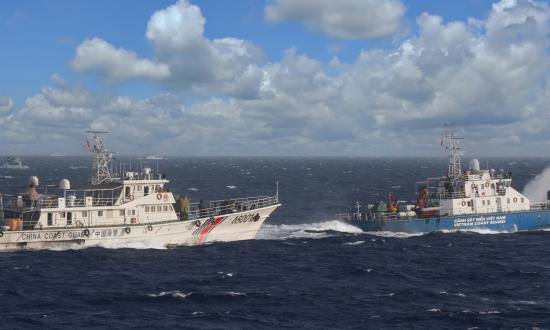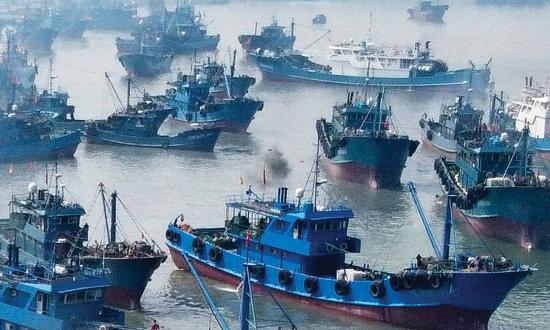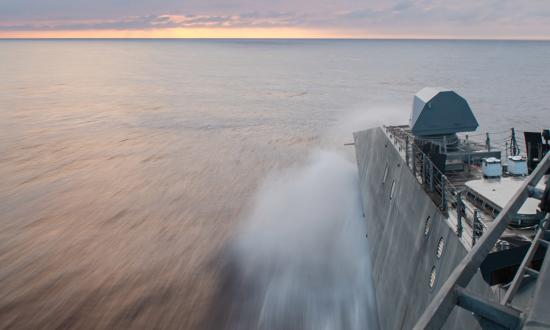In the South China Sea, China’s maritime insurgency strategy seeks to deny its neighbors their sovereign rights under the internationally recognized law of the sea—and make its proposals for “joint development” of other countries’ maritime bounty into an offer its neighbors cannot refuse. The geopolitical cost of this racketeering steadily compounds as China’s “gangsters wearing Coast Guard uniforms” push closer and closer to the edges of its nine-dash line claim. Although many are aware that exposing China’s thuggish behavior can serve as some measure of resilience, the dangers inherent in speaking out act as their own deterrent. However, there are other options.
Project Myoushu
Taking its name from an “inspired move” in the ancient game of Go, Project Myoushu was established in 2022 at Stanford University’s Gordian Knot Center for National Security Innovation (GKC) to take a blank-slate approach to solving the South China Sea maritime security dilemma. Following the “lean start-up” methodology built by entrepreneur and Stanford professor Steve Blank, this all-volunteer project team conducted more than 100 interviews with subject matter experts across a wide spectrum of disciplines, including U.S. and foreign military members, diplomats, intelligence professionals, think tank experts, authors, business leaders, defense innovators, journalists, and senior policy makers. The team settled on a novel approach to exploit the core weakness in China’s conflicting narratives—presenting to regional governments its dominance of the maritime commons as a fait accompli, while at the same time heralding a false “win-win” intent to their publics.
Project Myoushu presented its concept to a conference in early January 2023 hosted by Stratbase, a Manila-based business consultancy that also champions Philippine national security issues. During the presentation, the GKC Project Myoushu lead, retired U.S. Air Force Colonel Ray Powell, revealed a previously unreported December 2022 confrontation between a Philippine Navy vessel and a China Coast Guard (CCG) ship (numbered 3303) near Scarborough Shoal—a traditional Philippine fishing ground within the Philippines’ lawful exclusive economic zone (EEZ) that China seized in 2012 and has since controlled with an overwhelming coast guard and maritime militia presence. Powell’s revelation generated immediate domestic news headlines and vibrant social media commentary, and demonstrated the project’s potential to build Philippine national resilience against China’s gray zone activities.
Two weeks later, the project notched a second proof-of-concept success when Powell posted screenshots to Twitter demonstrating how a Malaysian Navy ship was monitoring another CCG ship (numbered 5303) while it harassed gas-field activities at Luconia Shoals in Malaysia’s EEZ. This tweet was picked up by a Malaysian-language online news site specializing in security affairs, which in turn generated questions to Malaysia’s defense minister at a news conference the following day.When the minister’s responses failed to satisfy Malaysian civil society’s expectations that he defend the country’s interests, the defense ministry issued a clarification clearly stating its policy that Malaysia had primary rights to Luconia Shoals. Once again, simply displaying information helped bolster national resilience against China’s gray zone activities.
Perhaps the clearest example of the project’s potential came in early February 2023, when Powell posted evidence that a CCG ship had harassed a smaller Philippine Coast Guard (PCG) vessel as it resupplied a Philippine-held outpost at Second Thomas Shoal, again resulting in news coverage of the allegation. A week later, the Philippines released photo and video evidence that the CCG vessel used a “military-grade laser” to “temporarily blind” the PCG crew. During a subsequent visit to Manila, Powell learned that Project Myoushu’s independent exposure of the harassment helped foster the conditions in which the government decided to go public, and ultimately to launch an effective new maritime transparency program led by the PCG.
Project Myoushu and Maritime Counterinsurgency (COIN)
The U.S. Naval Institute’s Maritime COIN Project explains China’s insurgency as “systematic maritime barbarism” that seeks to “overturn the rule of international law that enshrines the longstanding principle of the freedom of the sea” and “impose its own draconian, self-serving, hierarchical vision of maritime sovereignty, under which it claims distant ocean areas as blue national soil to deprive weaker coastal states of their own EEZs and fundamental rights at sea.” In practice, this is operationalized by the Chinese coast guard and maritime militia harassing its neighbors’ vessels rightfully operating in their own EEZs to erode public and government perceptions of their options. This was evident during the Philippine presidency of Rodrigo Duterte, who repeatedly explained reluctance to push back in the West Philippine Sea as necessary to avert war, and more recently by Malaysian officials who have been criticized for appearing to give legitimacy to China’s claims to Luconia Shoals.
Project Myoushu’s presence in the information domain, manifested through its newly created website SeaLight, provides reliable and timely accounts of gray zone operations as a credible third-party witness that empowers a variety of stakeholders. Analyzed maritime data provides content for local media to amplify using their own platforms. Increased public awareness generates support for regional governments to boost maritime security and push back against coercion.
As an independent, civil society–led initiative, Project Myoushu supports U.S. goals to expose and deter China’s gray zone activities while maintaining separation from potential public perceptions of bias and bureaucratic obstacles that can hinder government-led efforts. It also avoids the escalation risks associated with official government statements and supports local approaches. Through application of what Powell calls “assertive transparency,” Myoushu helps counter the asymmetric advantage China gains from its gray zone tactics by strengthening the resilience within and boosting international support to targeted nations, and by increasing the reputational cost China pays for those very tactics. China’s willingness to pay these costs is not limitless—and continual public exposure provides the most direct method to impose these costs.






